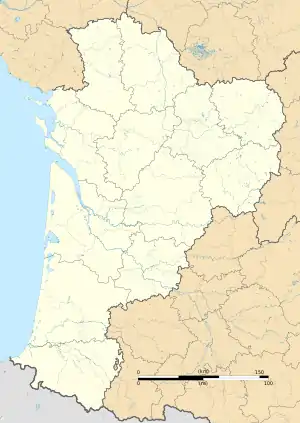La Coquille | |
|---|---|
%252Cchurch_and_square.JPG.webp) The church in La Coquille | |
 Coat of arms | |
Location of La Coquille | |
 La Coquille  La Coquille | |
| Coordinates: 45°32′36″N 0°58′38″E / 45.5433°N 0.9772°E | |
| Country | France |
| Region | Nouvelle-Aquitaine |
| Department | Dordogne |
| Arrondissement | Nontron |
| Canton | Thiviers |
| Government | |
| • Mayor (2020–2026) | Michèle Faure[1] |
| Area 1 | 22.37 km2 (8.64 sq mi) |
| Population | 1,261 |
| • Density | 56/km2 (150/sq mi) |
| Time zone | UTC+01:00 (CET) |
| • Summer (DST) | UTC+02:00 (CEST) |
| INSEE/Postal code | 24133 /24450 |
| Elevation | 259–432 m (850–1,417 ft) |
| 1 French Land Register data, which excludes lakes, ponds, glaciers > 1 km2 (0.386 sq mi or 247 acres) and river estuaries. | |
La Coquille (French pronunciation: [la kɔkij]; Occitan: La Coquilha) is a commune in the Dordogne department in Nouvelle-Aquitaine in southwestern France.
La Coquille was on one of the five routes leading to Santiago de Compostela in Spain and it was in this parish that pilgrims were given a coquille Saint-Jacques, a scallop shell symbolic of the Way of St. James, the celebrated pilgrimage to Santiago de Compostela. From this fact came the name of the village of La Coquille.
The church in La Coquille was on the route of Richard the Lionheart, was reinaugurated by him and welcomed him during his journey.
As a community, the name of La Coquille only appeared officially in 1856, replacing the name of Sainte-Marie-de-Frugie.
Geography
La Coquille is located in the Périgord in a heavily wooded area with meadows surrounding the peaceful little village. It is near the town of Nontron between Limoges and Périgueux. The Côle flows south through the northwestern part of the commune. La Coquille station has rail connections to Bordeaux, Périgueux and Limoges.
Population
| Year | Pop. | ±% p.a. |
|---|---|---|
| 1968 | 1,556 | — |
| 1975 | 1,692 | +1.20% |
| 1982 | 1,575 | −1.02% |
| 1990 | 1,515 | −0.48% |
| 1999 | 1,489 | −0.19% |
| 2009 | 1,364 | −0.87% |
| 2014 | 1,343 | −0.31% |
| 2020 | 1,269 | −0.94% |
| Source: INSEE[3] | ||
See also
References
- ↑ "Répertoire national des élus: les maires" (in French). data.gouv.fr, Plateforme ouverte des données publiques françaises. 13 September 2022.
- ↑ "Populations légales 2021". The National Institute of Statistics and Economic Studies. 28 December 2023.
- ↑ Population en historique depuis 1968, INSEE